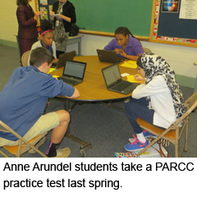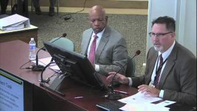 |
|
The Maryland State Department of
Education will unveil the first round of state-level data from new state
assessments later this month.
Officials will release statewide
data on the high school tests in algebra and English 10 at the October 27
meeting of the Maryland State Board of Education. State data for the elementary and middle
school assessments in mathematics and reading/English language arts will follow
at the December 8 state board meeting.
Home reports will be issued in November for high school students and
December for elementary and middle school students.
|
“This will be baseline data, and
will provide educators and parents with a snapshot of where Maryland students
are at this point in time on this assessment,” said Dr. Jack Smith, Interim
State Superintendent of Schools. “State
assessments are just one measure to use when viewing student progress; they
provide Marylanders with an important data point from which to build.”
These will mark the first data
release involving Maryland students who took the Partnership for Assessment of
Readiness for College and Careers (PARCC) tests given last spring for the first
time. As with any major new assessment,
the test results were subject to a performance level setting process, which
took place late this summer. Future
PARCC test results will be available sooner as more students are assessed
online. More than 82 percent of students
took online assessments during the first administration. Paper-pencil assessments are available as
needed in the first three years.
The PARCC assessments are aligned to
Maryland’s College and Career Ready Standards, which set a higher bar for
student learning. The tests go beyond
the old “fill in the blank” model of standardized tests, and include more
writing and analytical thinking.
PARCC represents a complete reset of
Maryland’s accountability program. Data
on the new exams will not be comparable to results of the Maryland School
Assessment (MSA), which the State used for a decade. The MSA results were based on the previous
academic standards, which have not been in use since 2013-14. Some systems began implementation of the new
College and Career Ready Standards as early as 2011-12.
The new assessment data will help
tell parents and teachers what younger students need to know to advance to the
next grade. For older students, the
information will help gauge if they are learning what is necessary to graduate
ready for college without needing remediation, or are prepared for more complex
and higher paying jobs. A low score on
PARCC does not mean a child is failing to learn, but rather that improvement is
needed to reach new grade-level expectations.
Thirteen Maryland educators were
involved in the performance setting process on the new test late this summer,
during which experts set the following levels:
- Level
5 - Exceeded Expectations
- Level
4 - Met Expectations
- Level
3 - Approached Expectations
- Level
2 - Partially Met Expectations
- Level
1 - Did Not Yet Meet Expectations
The MSA
had just three performance levels and were set at a less rigorous target. The result: most students were considered
proficient in the subject matter when Maryland adopted the plan for higher
standards and more advanced assessment in 2010.
This pattern of raising standards and creating new assessments has been
in place in Maryland since the 1980s.
The new
PARCC assessments are designed to eliminate the need for additional coursework
before students take credit-bearing courses beyond high school. Levels 4 and 5 indicate readiness for
postsecondary education.
 |
|
Maryland
educators are continuing to report progress in the statewide implementation
process for Teacher and Principal Evaluation systems, according to a new
report.
“Change in Practice in Maryland: Student
Learning Objectives and Teacher and Principal Evaluation,” issued last
week by the Mid-Atlantic Comprehensive Center at WestEd and the Community
Training and Assistance Center (CTAC), found expanded support for the
evaluation process. The report zeroes in on the use of Student Learning
Objectives (SLOs) as a tool to measure student growth and improve instruction,
finding that major strides continue in the use of SLOs.
|
“Maryland
is a national leader in developing a broad base of support for a TPE system
that is instructionally focused,” said William Slotnik, founder and executive
director of CTAC. “It is a system that provides both support and
accountability.”
The report
presented last week by Dr. Slotnik to the Maryland State Board of
Education--the third in a series-- revealed that Teacher and Principal
Evaluation (TPE) is prompting principals and teachers to deepen their
reflection on the learning process, and has sparked increasingly data-rich and
focused conversations about instruction in their school and school system.
School
system leaders increasingly credit the Maryland State Department of Education
(MSDE) with effective help in implementing TPE.
“Maryland has successfully addressed the initial challenges of TPE,” the
report says, but it notes that principals and teachers need more support in key
areas of implementation. Those
challenges have evolved since the process began, the report adds.
“This
process cannot work effectively without partners in the classroom, school
building, and system office, and we’ve had that from the very beginning,” said
Interim State Superintendent of Schools Jack R. Smith. “When we work collaboratively to strengthen
teaching and learning, our students and our communities win.”
MSDE has
involved all 24 school systems and various stakeholders in the professional
development process for Teacher and Principal Evaluation. MSDE and the Maryland
State Board of Education in June joined the Maryland State Education
Association, Public School Superintendents Association of Maryland, Maryland
Association of Boards of Education, Maryland Association of Secondary School
Principals, Maryland Association of Elementary School Principals, and the
Baltimore Teachers Union in a Memorandum of Understanding pledging to
coordinate resources and strategies in the development of rigorous and
measurable SLOs as part of that process.
The
Mid-Atlantic Comprehensive Center, funded by a grant from the U.S. Department
of Education, partnered with MSDE to conduct the study. The study team included researchers from both
CTAC and WestEd. The study is a
continuation of earlier work by CTAC and WestEd and is designed to further
strengthen Maryland’s implementation of TPE and its SLO component. SLOs are measurable instructional goals
established for a specific group of students over a set period of time. SLOs
serve as one of the measures of student growth for the State Teacher Evaluation
model.
Read our full report,"Change in Practice in Maryland: Student Learning Objectives and Teacher and Principal Evaluation.

Interim State Superintendent of Schools
Jack R. Smith
|
Maryland public education this week welcomed six new National Blue Ribbon schools, and each one deserves high praise.
The State public schools receiving national honors are:
- Lake Shore Elementary School, Anne Arundel County
- Severna Park Elementary School, Anne Arundel County
- Pine Grove Elementary School, Baltimore County
- Kemptown Elementary School, Frederick County
- Fountain Green Elementary, Harford County
-
Smithsburg High School, Washington County
Maryland awarded the six schools State Blue Ribbons last December. Today’s honor verifies the excellence of those schools.
These six schools proudly represent the outstanding education taking place in schools and classrooms throughout Maryland. We know that everyone contributes to the success of these schools, from the students to the teachers, to the administrators, to the parents and communities. Everyone deserves congratulations.
* * *
Heroin and opioid addiction has reached epidemic proportions, both in Maryland and throughout the nation. That’s why I joined Lt. Governor Boyd K. Rutherford this week at Towson High School to announce a new public education and prevention program designed to help stem the abuse of these dangerous drugs across the Maryland.
The new program is an outgrowth of Governor Larry Hogan’s Statewide
focus on heroin and opioid abuse. Governor Hogan earlier this year kicked
off an effort to combat heroin abuse, bringing together experts and
advocates in the 11-member Heroin and Opioid Emergency Task Force. Lt.
Governor Rutherford chairs the task force, which in August released an
interim report. A final report is due at the end of the year.
The Maryland State Department of Education is partnering with multiple State agencies and the Lt. Governor’s office on a coordinated, multi-tiered public education campaign to address the heroin epidemic.
The campaign is focused on prevention by discouraging teens and preteens from trying the drug even once. The initiative is intended to educate students and parents on how to identify and respond to signs of addiction; and how to access support services.
Heroin and opioid abuse reaches every corner of our State, and schools have an important role to play in educating children about this crisis. The best way to reduce drug abuse is to stop it before it begins.
MSDE will be partnering with local systems and community organizations to increase awareness of the heroin crisis and supports available. MSDE also will incorporate heroin/opioid prevention into the State health curriculum earlier and in a broader way, infuse heroin/opioid prevention into additional disciplines and content areas, and integrate heroin/opioid addiction as a topic that could be addressed in service learning projects.
 |
|
2015 Principals of the Year!
Maryland celebrates its new 2015 Principals of the Year! Honorees Carol Hahn, Matthew Wagner, Ashanti Foster, Monifa McKnight, and John Baugher are recognized for their hard work before the Maryland State Board of Education.
|
 |
|
PARCC Update
Interim Deputy State Superintendent Dr. Henry Johnson and Dr. Douglas Strader of
MSDE's Division of Curriculum and Assessment present an update on
PARCC.
|
 |
|
Wolfe St. Academy in Upper Fells Point
Wolfe St. Academy in Upper Fells Point celebrates 10 years as a
Community School and 8 years as a Baltimore Curriculum Project
conversion charter school. The Abell Foundation now ranks WSA #2 among
all public elementary schools in Baltimore in achievement on the
Maryland School Assessment.
|
October
9 - Teacher of the Year Gala, Baltimore
October
27 - Maryland State Board of Education Meeting
Maryland Schools Receive National Blue Ribbon Honors
Baltimore Sun
Fountain Green Wins National Blue Ribbon
Aegis
Smithsburg High is a Blue Ribbon School
Herald Mail
|